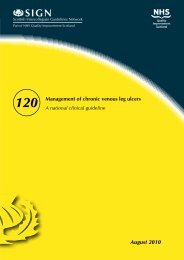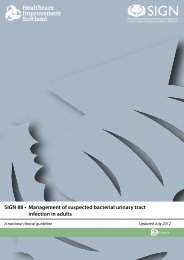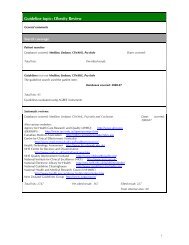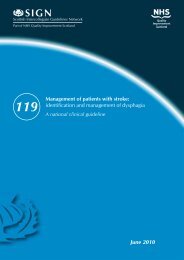Diagnosis and pharmacological management of Parkinson's - SIGN
Diagnosis and pharmacological management of Parkinson's - SIGN
Diagnosis and pharmacological management of Parkinson's - SIGN
You also want an ePaper? Increase the reach of your titles
YUMPU automatically turns print PDFs into web optimized ePapers that Google loves.
<strong>Diagnosis</strong> anD Pharmacological <strong>management</strong> <strong>of</strong> Parkinson’s Disease<br />
18<br />
Although the relative prevalence <strong>of</strong> dyskinesias with long term levodopa therapy may resemble<br />
that <strong>of</strong> dopamine agonists, 68 there is evidence that patients treated with levodopa therapy for four<br />
to six years have approximately a 40% likelihood <strong>of</strong> experiencing motor fluctuations <strong>and</strong> a 40%<br />
risk <strong>of</strong> dyskinesias. 69 Alternative therapeutic agents are <strong>of</strong>ten employed as first line treatment to<br />
delay starting levodopa <strong>and</strong> thereby reduce the onset <strong>of</strong> disabling dyskinesias.<br />
Nausea <strong>and</strong> vomiting, common adverse effects <strong>of</strong> levodopa <strong>and</strong> DAs (see Annex 4), can be treated<br />
with domperidone, a peripheral D2 antagonist in a dose <strong>of</strong> 10-20 mg three times daily. 70<br />
a Patients with early Parkinson’s disease <strong>and</strong> motor symptoms may be considered for<br />
treatment with levodopa in combination with a dopa decarboxylase inhibitor.<br />
; The lowest effective dose <strong>of</strong> levodopa should be used to minimise the incidence <strong>of</strong><br />
adverse effects.<br />
Impulse control disorders (ICDs) are uncommon with levodopa monotherapy. Pathological<br />
gambling <strong>and</strong> other ICDs may occur with dopamine dysregulation syndrome (DDS) where<br />
patients self escalate doses <strong>of</strong> levodopa <strong>and</strong>/or apomorphine to levels above those required<br />
to control motor symptoms <strong>and</strong> patients with DDS <strong>of</strong>ten exhibit severe dyskinesia <strong>and</strong> ‘<strong>of</strong>f’<br />
period dysphoria. 71<br />
; Surveillance for dopamine dysregulation syndrome should be undertaken in patients<br />
receiving levodopa or intermittent apomorphine.<br />
5.1.2 DOPAMINe AGONISTS<br />
One meta-analysis, two systematic reviews <strong>and</strong> a number <strong>of</strong> RCTs have looked at the efficacy <strong>of</strong><br />
DAs in early PD. Overall, dopamine agonists improve the motor symptoms in early disease with<br />
significant improvements in uPDRS total, motor, <strong>and</strong> activities <strong>of</strong> daily living (ADl) scores.<br />
R<strong>and</strong>omised trials comparing the effectiveness <strong>of</strong> dopamine agonists with placebo in patients<br />
with early PD have shown a significant improvement in uPDRS scores for agonist-treated<br />
patients, in particular for part III motor examination scores. 72-77<br />
A meta-analysis <strong>of</strong> DA therapy in patients with early PD included 29 RCTs involving 5,247<br />
participants. 78 Dopamine agonists were associated with fewer motor complications compared<br />
to levodopa but other important side effects were increased <strong>and</strong> people treated with agonists<br />
were more likely to discontinue treatment due to adverse events (odds ratio OR 2.49, 95%<br />
CI 2.08 to 2.98; p








